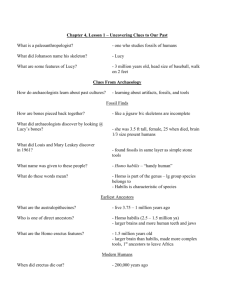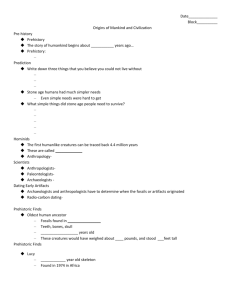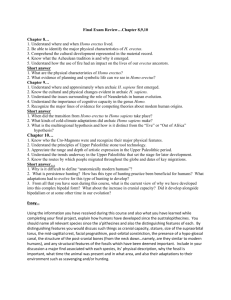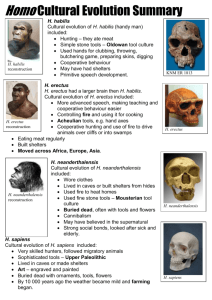The Homo Genus Lab Report
advertisement
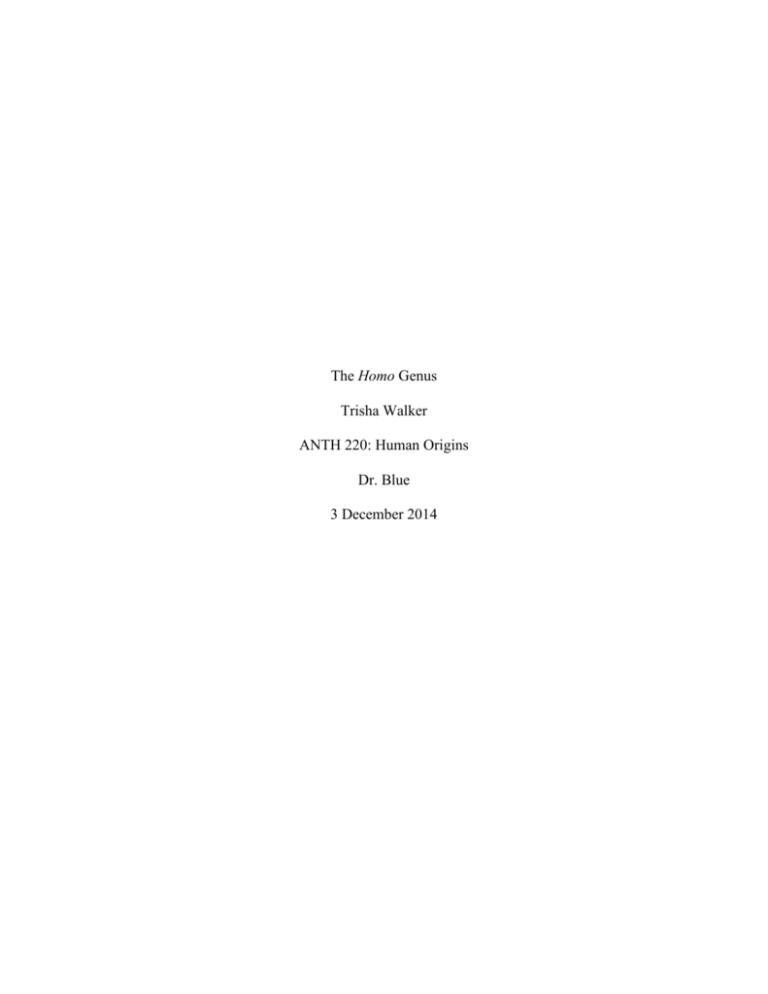
The Homo Genus Trisha Walker ANTH 220: Human Origins Dr. Blue 3 December 2014 Walker 1 Objectives Modern humans began to appear around 200,000 years ago; they had new characteristics such as a higher forehead, a globular skull with a small face and smaller molars, and a projecting chin. They either emerged in Africa, like their predecessors, or emerged multiregionally and went on to become the dominant Homo genus. Predecessors of modern day humans include Homo habilis, Homo erectus, Homo heidelbergensis, and Neanderthals. H. habilis was the first hominid to have anatomical and behavioral characteristics that were similar to those of the later Homo sapiens. It lived around 1.8 to 2.5 million years ago, and had smaller teeth and a larger brain than its Australopithecus ancestors; however, it still retained its Australopithecus-like body. H. erectus was first identified by Eugene Dubois in Java in the 1890s. H. erectus was the first hominin to leave Africa. The earliest H. erectus fossils found in Africa date to 1.7 million years ago, while they were found outside of Africa up to 1.8 million years ago. Anatomically, they were much larger than previous Homo species, increasing in body size up to 100 pounds and growing up to 5 foot 6 inches all. Otto Schoetensack discovered Homo heidelbergensis near Heidelberg, Germany in 1907. It lived throughout Africa, Europe, and western Asia until around 250,000 to 200,000 years ago, and is considered to be evidence of early transitional species in Africa. They are possibly thought to have been the ancestors of the Neanderthals and H. sapiens. Neanderthals are considered to be archaic H. sapiens because they were able to interbreed with our human ancestors, and their DNA can still be found in us today. They inhabited Europe, Western Africa, and the Middle East. Neanderthals were the first non-modern H. sapiens species discovered, unearthed in 1856 in Neander Valley, Germany. They were initially stereotyped as Walker 2 unintelligent cave men, but they had a larger brain than us and perhaps even taught us some of their tool manufacturing skills. Materials and Methods The first lab section involved comparing H. habilis and H. erectus crania. The skulls examined were ER 3733: ML-P-13 and ER 1813: ML-P-11. Cranial morphology was compared as well as brain size and dentition. The following lab section compared the femurs of H. habilis and H. erectus. The specific femurs were ML-P-7 and ML-P-61 respectively. The two femurs were measured using an osteometric board, sliding calipers and measuring tape. The third lab section compared the following H. erectus skulls: Dmanisi (ML-P-75), Sangrian (ML-P-51), Nariokotome Boy (ML-P-14) as well as the other H. erectus skulls in the lab. H. erectus morphology was compared between the crania, including pentagonal head shape, sagittal keel, supraorbital torus, nuchal torus, and prognathism. Next, in the fourth lab section, the mean brain volume for the following species: Gorilla gorilla, Pongo pygmaeus, Pan troglodytes, Pan paniscus, Australopithecus afarensis, Australopithecus africanus, Paranthropus boisei, and Homo habilis. The male/female difference was calculated by subtracting the female mean from the male mean brain volume. The Index of Dimorphism was also determined by dividing the male mean by the female mean brain volume. The fifth lab section compared Homo erectus (ML-P-53), Homo heidelbergensis (ML-P92), and Homo neanderthalensis (ML-P-76) skulls. Traits compared included size of skull, supraorbital torus, teeth, shape of skull, prognathism, and nose. Finally, in the last lab section, the earliest tool type (Oldowan) was compared to the toolkit associated with H. erectus (Acheulian) and that of H. neanderthalensis (Mousterian). They were compared via overall size, number of faces, and number of blows necessary to form the tool. Walker 3 Results/Conclusions In the first lab section, the overall cranial morphology differed between H. erectus and H. habilis. H. habilis ML-P-12 had a smaller cranial shape than ML-P-11, however they both were longer and more football shaped the H. erectus, which was more rounded on the occipital bone. All of the crania had supraorbital tori. Furthermore, the H. erectus had the largest brain cavity. The two H. habilis had postorbital constriction and thus less room in their brain cavity. Finally, the H. erectus dental arcade was more parabola shaped than the H. habilis, and they both had small molars. The results from the measuring of the two femurs of H. erectus and H. habilis can be found in Table 1. H. erectus had a larger femur and is generally larger in other aspects, such as diameter of the femoral head and the epicondylar breadth. However, H. habilis had a larger femoral head. The ration of femoral height to overall height in H. habilis was smaller femur for smaller height, and the ratio of femoral height to overall height in H. erectus was larger femur for larger height. The third lab section compared the skulls of three H. erectus individuals showing species variations; the three skulls examined belonged to Dmanisi, Sangrian, and Nariokotome Boy. Dmanisi had a globular skull with a sagittal keel, a supraorbital torus, a nuchal torus, and slight prognathism. Sangrian had a pentagonal shaped skull with a small sagittal keel, a supraorbital torus, a very prominent nuchal torus, and showed prognathism. Lastly, the Nariokotome Boy had a globular skull with a very small sagittal keel, a damaged supraorbital torus, small nuchal torus, and slight prognathism. The results of the fourth lab section results can be found in Table 2. The male/female difference in mean brain volume of eight great ape and hominin species were calculated, along Walker 4 with their index of dimorphism. The hominin values were all larger than the male/female difference of great apes, and the hominin index of dimorphism was greater, on average, than those of the great apes. H. habilis had a larger male/female difference, the largest out of the hominins and even larger than the great apes. H. habilis also had the largest index of dimorphism for males and females in cranial capacity. Similarly, the results of the fifth lab section can be found in Table 3. The cranial of H. erectus, H. heidelbergensis, and H. neanderthalensis were compared. H. erectus had the smallest skull size as well as a globular shape, a prominent supraorbital torus with an arch in the middle, smaller teeth, a slightly more protruding mouth and teeth, and no nose ridge. H. heidelbergensis had a medium sized skull with an arched and prominent supraorbital torus, smaller teeth, a pentagonal skull shape, small/barely protruding prognathism, and an outward pointing nose ridge. H. neanderthalensis had the largest skull, with a prominent supraorbital torus, smaller teeth with the last molar curved in, a slightly protruding mouth, and a protruding nose ridge. Finally, the Oldowan, Acheulian, and Mousterian tool kits were compared in overall size, number of faces, and the number of blows it took to form the tool. The Acheulian tool was the largest, but the Mousterian tool had the most faces. The Mousterian tool also took the most number of blows to form. Discussion In the first lab section, the crania of H. habilis and H. erectus were compared. H. erectus exhibited more modern traits, like the globular skull and a larger brain cavity. H. erectus also had a more parabola shaped dental arcade, which is similar to modern H. sapiens. Walker 5 Next, when the two femurs of H. habilis and H. erectus were compared, it was noted that the two femurs were similar in size. However, the average height of H. erectus was 5’6’’ while H. habilis had a mean height of 5’. This concludes that the six-inch height increase with H. erectus must have been distributed in its spine and tibia – places other than its femur. The Dmanisi, Sangrian, and Nariokotome Boy H. erectus skulls showed the variation that can take place within a species. Because of the characteristics that the skulls had, the Nariokotome Boy was probably more recent than the Sangrian because Sangrian had more primitive characteristics. Additionally, in the fifth lab section when H. erectus skulls were compared to H. heidelbergensis and H. neanderthalensis, the three skulls showed similarities to H. sapiens in smaller teeth, more globular trending skulls, and less prognathism. Finally, in the last lab section, different tool kits were observed. The Oldowan tool kit is the oldest; the stone tools were primitive and didn’t take many blows to make. The Acheulian tools were made by H. erectus; these tools were the largest, had a lot of faces, and took a lot of blows to make. Lastly, the Mousterian tools were created by H. neanderthalensis and were smaller, more compact. These tools had the most detail and took the most effort to make. The Neanderthals had the most brainpower out of our hominin ancestors, and therefore made the most difficult tools. Walker Tables and Figures Table 1. Femur measurements of Homo habilis and Homo erectus. Maximum length Bicondylar length A-P diameter of midshaft M-L diameter of midshaft Maximum diameter of head Vertical diameter of head Horizontal diameter ofhead Subtrochanteric A-P diameter Subtrochanteric M-L diameter Midshaft circumference Epicondylar breadth Homo habilis 394 mm 370 23.1 23.6 41.41 38.28 40.54 22.7 29.7 75 67 Homo erectus 430 mm 395 21.3 19.8 46.81 33.01 31.89 23.69 32 63 72 Table 2. Dimorphism in mean brain volume in male and female primate and early hominid species. Species Sex Mean M/F Difference Gorilla gorilla Male Female Male Female Male Female Male Female Male Female Male Female Male Female Male Female 535 456 434 375 398 371 356 329 500 400 490 430 507 437 700 551 79 Index of Dimorphism (M/F) 1.17 59 1.16 27 1.07 27 1.08 100 1.25 60 1.14 70 1.16 149 1.27 Pongo pygmaeus Pan troglodytes Pan paniscus A. afarensis A. africanus P. boisei H. habilis 6 Walker 7 Table 3. Skull comparison of three early Homo species. Size of skull Supraorbital torus Teeth Shape of skull Prognathism Nose H. erectus Smallest skull Prominent arch in middle Smaller teeth H. heidelbergensis Medium sized Arched, prominent H. neanderthalensis Largest skull, oblong Prominent Smaller teeth Globular Slightly protruding mouth, teeth No nose ridge Pentagonal Small, barely protruding Pointing out nose ridge Last molar curved in, smaller teeth Longer, round Slightly protruding mouth Nose ridge protruding, very prominent
